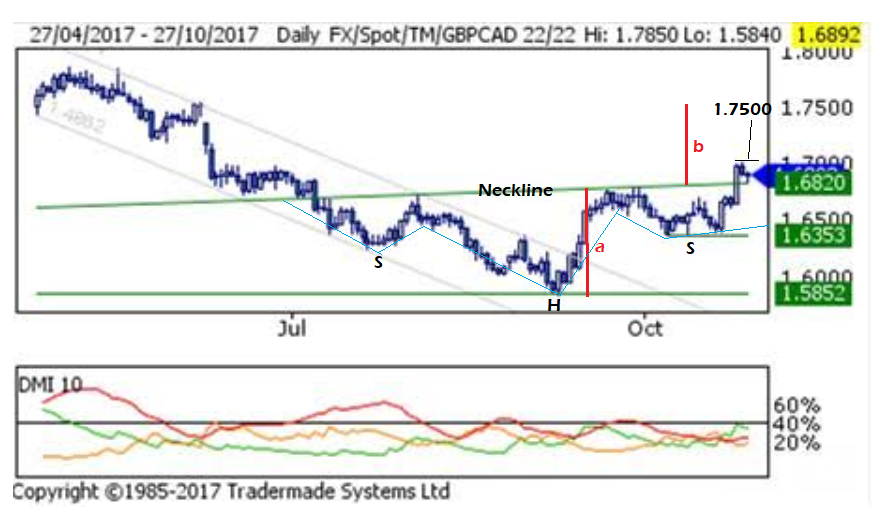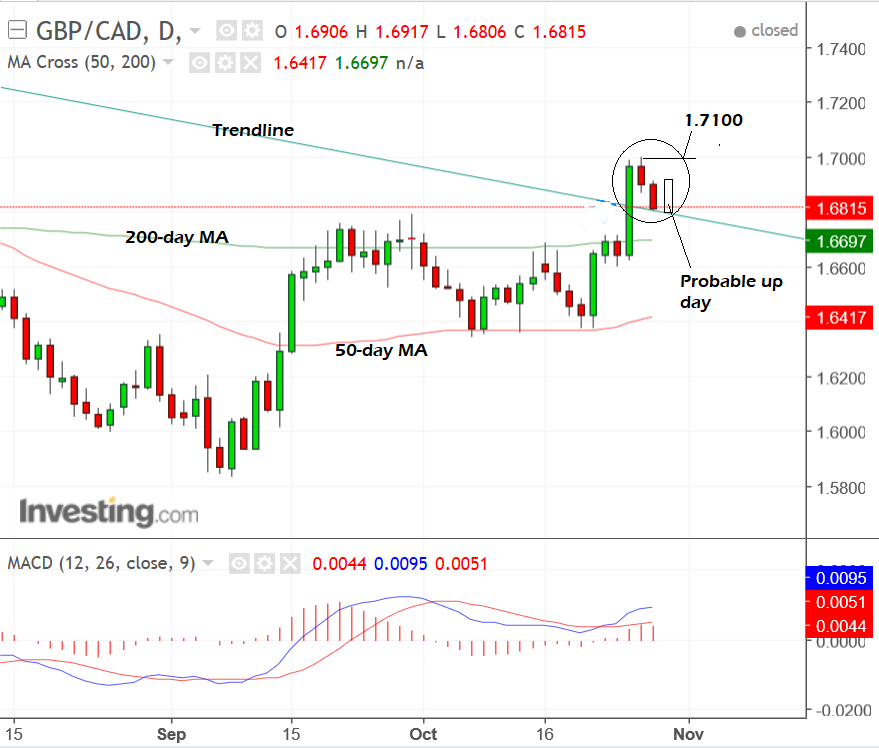Sterling Tipped to Resume Uptrend vs. Canadian Dollar in Coming Week

Multiple bullish signals adorn the GBP/CAD price chart, which combined with a probable interest rate rise in the UK suggests more upside for the pair.
Our technical studies note the Pound-to-Canadian Dollar exchange rate is in an uptrend and has broken above an important long-term trendline signaling that it will probably continue rising.
Technical studies try and anticipate future moves in an exchange rate by considering the structure of the market which is illustrated by previous price action - history tends to repeat itself and selling and buying interest tends to rest around particular levels which therefore have real and material impacts on moves in the exchange rate.
Following the break above the trendline on Wednesday, the exchange rate immediately pulled back for two days and 'retested' the trendline.
This type of pull-back, after a major trendline break, is called a 'throwback' move and normally precedes a resumption of the uptrend - it is merely a step back or 'pause' for buyers to 'collect themselves' before the trend higher resumes.
Another sign the uptrend will probably resume is the configuration of the last three day's trading activity (circled on the chart above).
Wednesday was a long green bullish day when buyers pushed the exchange rate above the trendline for the initial break.
This was followed by a shorter red down day when the throwback began and then on Friday another short down day brought the exchange rate back down to the level of the trendline again.
This configuration of a long bullish candle followed by two smaller bearish candles indicates a high probability - of about 66% - that the next day will be an up day.
Therefore, we see a higher chance Monday will end on an up and that after that the exchange rate will continue rising as the bullish short-term uptrend resumes.
For confirmation, we would ideally wish to see a break above the October 26 highs of 1.7005, which would probably be followed by a continuation up to a target at 1.7100.
Bottoming Pattern
Adding further fuel to the bullish thesis is analysis from Canadian lender Scotiabank's FX Strategist Shaun Osborne, who also sees the pair rising but for different, though equally compelling, reasons.
Scotia's Osborne argues the pair has formed a bottoming pattern called an inverted head and shoulders (H&S) pattern, which bodes extremely bullish for the pair.
An inverted H&S is an upside-down variation of the classic head and shoulders topping pattern, which consists of three peaks with the central peak taller than the two either side, thus recalling the 'head' of a person, and the two other peaks of a similar but shorter height, recalling the shoulders.
The inverted H&S is the same but upside down such that the middle trough is the lowest and the two either side are of a similar but not as deep depth.
The inverted H&S has a neckline at the level of the two intervening peaks of the pattern which must be breached for the pattern to be confirmed and more upside forecasted.

In Scotia's example, the neckline has already been breached and the pair has performed a throwback to the neckline over the last two days - similar to the throwback to the trendline.
Now that it has retested the neckline the pair is expected to start moving higher towards the target for the inverted H&S, which is calculated by taking the height of the pattern at its tallest point (labelled 'a' on the chart) and extrapolating it from the neckline higher ('b'), which gives a conservative target at about the 1.75 level - although Osborne places the target in the 1.77s.
"GBPCAD dipped to retest the neckline of the bullish, inverse H&S formation (targets a move to the upper 1.77s) earlier but intraday patterns suggest a low/reversal formed above 1.6820 earlier, forming a minor bull signal (“hammer” low/reversal) in the process," says the strategist, adding:
"We are bullish while the 1.68 area holds (keeping in mind that we can allow for a modest infraction of the neckline trigger, provided it is limited in terms of scale and duration)."
Get up to 5% more foreign exchange by using a specialist provider by getting closer to the real market rate and avoid the gaping spreads charged by your bank for international payments. Learn more here.
Data and Events for the Canadian Dollar
The main release in the coming week for the Canadian Dollar (the Loonie) is employment data out on Friday, November 3 at the same time as US Non-Farm Payrolls (12.30 GMT).
The labour market is forecast to show additional 15k workers in October whilst the Unemployment rate is expected to remain at 6.2%.
Also of note for the Loonie is that the governor of the Bank Of Canada (BOC), Steve Poloz is scheduled to speak twice in the week ahead - once on Tuesday at 19.30, and then on Wednesday evening at 20.15.
Poloz and the BOC have been engaged in something of a subtle U-turn from a previously hawkish stance to a more dovish stance of late, which has been weighing significantly on the Loonie.
Previously the BOC envisaged several more rate rises due to the economy making headway, however, some iffy data recently has led them to take a more cautious line and Poloz's speeches will be analyzed within that context.
Clearly, a continuation of the U-turning to a more dovish position (dovish meaning in favour of lower interest rates) would weaken the Loonie which tends to follow the path of interest rates, whilst a neutral or trenchant hawkish stand will support CAD as it will imply the possibility of higher interest rates on the horizon.
Events and data for the Pound: BoE Centre Stage
The big event to watch in the week ahead is the Bank of England's Inflation Report and Monetary Policy Decision, due on Thursday, November 2.
Money markets are currently pricing in a 90% chance that the Bank will raise interest rates - so the immediate risk to Sterling is if they don't raise rates. In such a scenario expect the Pound to plummet.
Such a move would be unlikely however as the Bank's Monetary Policy Committee know their reputation is at stake; in short, there will be few who take the words of Governor Mark Carney and his lieutenants seriously should he not follow through with a 0.25% rate rise.
An interest rate rise on its own would be neutral, as it is well signposted. What matters is communication regarding future policy moves - is there going to be a follow-up rate rise in 2018 or not? If yes, this would be positive for Sterling, if no, this would be bearish.
Financial markets are now pricing in a rise in 2018 which is more in line with Carney's view and so he may express satisfaction that they are correctly pricing probabilities.
"The picture is still cloudy enough for some UK rate-setters to question the need for immediate action. Nevertheless, we expect the Committee to move ahead with a 0.25% increase," says Lloyds Commercial Banking's Senior Economist Rhys Herbert, adding:
"With regard to the Bank’s forward guidance, of most interest will be whether Carney reiterates his previous assertion that markets are underestimating the potential for interest rate rises."
Yet at the same time, Carney is still expected to emphasise that interest rate rises are likely to be "gradual".
The big debate for Sterling going forward is whether the interest rate is a once-and-done affair or the start of a new cycle.
Whichever side you fall on is likely to determine whether you are bullish, or bearish on Sterling.
“For investors, the key question is whether or not there will be further hikes next year. Market expectations are for at least one further 25bp hike next year. In contrast, we think the MPC will be making a mistake by hiking now, and that they will recognize this in the coming months,” says Daniel Vernazza, UK economist at UniCredit.
On the other side of the coin is the view that we are at the start of a new cycle of rate rises.
“It is not clear to us that UK growth is about to falter suddenly. There may be further Brexit negotiation uncertainty, but there is arguably a lot of it already. Instead, we prefer to trade with conviction the idea that this is not a policy mistake and that the BoE is on a hiking cycle,” says Jordan Rochester at Nomura.
As a result, Rochester is betting the Pound-to-Euro exchange rate will rise towards 1.15 near-term.
PMIs
Another major release for the Pound in the week ahead is the results of the October Purchasing Manager surveys for Manufacturing, Construction, and Services.
These are out at 9.30 on Wednesday 1, Thursday 2 and Friday 3 respectively.
Manufacturing is forecast to fall to 55.8 from 55.9 by the consensus of economists, although, some such as Lloyds's Herbert see an even lower result as likely due to the decline in the CBI Industrial Trends survey last week.
However, this is with the proviso that the Manufacturing PMI has been overall in an upbeat trend.
Lloyds Bank's Herbert is more constructive about Services PMI which he expects to come out at 54.0, however, the consensus expectation is for a fall to 53.2 from 53.6.
Finally, in the coming week Brexit Minister David Davis is to be questioned on the progress of negotiations on Tuesday at 16.05 (UK), and clearly how he answers is likely to impact the Pound given how hypersensitive the currency is to Brexit headlines.
Get up to 5% more foreign exchange by using a specialist provider by getting closer to the real market rate and avoid the gaping spreads charged by your bank for international payments. Learn more here.





